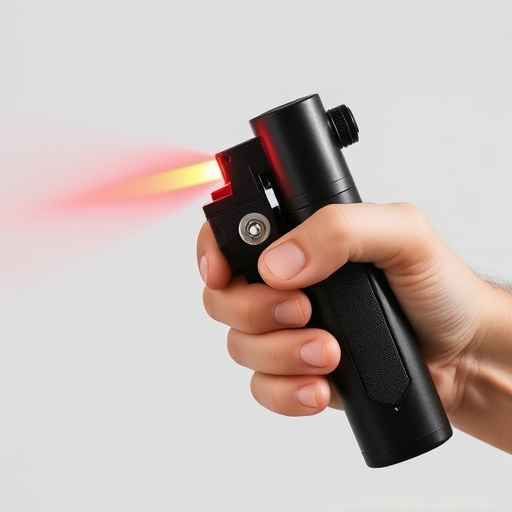Tactical pepper spray (oleoresin capsicum, or OC spray) is a powerful self-defense tool that temporarily disables attackers by irritating their eyes and respiratory systems. Effective deployment methods vary based on distance and situation, from direct spraying for close encounters to burst techniques for longer ranges. Understanding these methods, local laws, and safe handling practices is crucial for optimal use in scenarios like muggings, intrusions, or animal attacks, ensuring its effectiveness while minimizing risks and legal issues.
“Uncover the power of tactical pepper spray as a vital personal security tool in modern self-defense strategies. This comprehensive guide explores ‘Understanding Tactical Pepper Spray’ and delves into its role as an effective deterrent. We dissect various deployment techniques, from aim to trigger pull, emphasizing the importance of training and practice. Additionally, this article navigates legal considerations and safety precautions, ensuring responsible usage. Discover the art of tactical pepper spray deployment methods for enhanced personal protection.”
- Understanding Tactical Pepper Spray: A Comprehensive Overview
- The Role of Personal Security in Self-Defense Strategies
- Deployment Techniques: Effective Use of Pepper Spray Canisters
- Legal Considerations and Safety Precautions for Pepper Spray Users
Understanding Tactical Pepper Spray: A Comprehensive Overview
Tactical pepper spray, also known as oleoresin capsicum (OC) spray, is a powerful personal security tool designed to incapacitate an assailant temporarily. It works by irritating the eyes and respiratory system, causing temporary blindness, coughing, and difficulty breathing. Understanding how to deploy tactical pepper spray effectively is crucial for its optimal use in self-defense scenarios.
There are several deployment methods for tactical pepper spray, each suited to different situations. The most common method involves a simple trigger mechanism, where the user aims and activates the spray by pressing a button or pulling a lever. This direct spraying technique is effective for close-range encounters. For longer distances, users can employ a burst or fogging technique, allowing them to create a cloud of pepper spray that fills the assailant’s respiratory system and vision. Additionally, some advanced models offer a tactical stream option, providing a concentrated, powerful jet of spray for maximum impact in threatening situations.
The Role of Personal Security in Self-Defense Strategies
Personal security is a vital component in any self-defense strategy, and tactical pepper spray is one tool that plays a significant role in this domain. In today’s world, where unexpected threats can arise anywhere, individuals are increasingly recognizing the importance of being prepared. Pepper spray, or tactical chili spray, offers a non-lethal yet effective means of self-protection against potential assailants. Its deployment methods vary, but each is designed to incapacitate an attacker temporarily, giving users precious time to escape or seek help.
Knowing how and when to deploy pepper spray is crucial. Tactical pepper spray deployment methods include hand-held canisters for close-range defense, as well as more advanced systems integrated into clothing or gear for stealthy and swift protection. The versatility of these tools allows individuals to take control in various scenarios, whether facing muggers, intruders, or animal attacks. With proper training, one can master the art of using pepper spray effectively while minimizing harm to oneself and others.
Deployment Techniques: Effective Use of Pepper Spray Canisters
When it comes to tactical pepper spray deployment methods, understanding how and when to deploy your canister is key. The first step is to assess the situation; identify potential threats and consider the proximity and number of aggressors. This evaluation allows for a strategic decision on whether to use a quick burst or a sustained stream.
A common technique is the ‘aim and fire’ method, where the user aims at the face or eyes of the attacker, pulling the trigger to release a concentrated spray. This can stun an assailant momentarily, providing an opportunity to escape or subdue them further. For close-quarters combat, a strategic sweep of the canister across an area can be effective in disorienting multiple opponents, allowing for a tactical retreat or the chance to dominate the situation.
Legal Considerations and Safety Precautions for Pepper Spray Users
When carrying and using tactical pepper spray, it’s crucial to understand the legal considerations in your region. Laws regarding self-defense and pepper spray vary widely, with some areas restricting its use to law enforcement only, while others allow civilians to protect themselves. Before deploying any form of pepper spray, users must be aware of their rights and responsibilities; failure to comply with local regulations can result in serious legal repercussions.
Safety precautions are paramount when handling tactical pepper spray. Users should receive proper training on safe storage, handling, and deployment methods to minimize accidental discharge and ensure effectiveness. Pepper spray is not a casual tool; its use should be a last resort in dangerous situations. Familiarize yourself with different deployment methods, such as the finger-trigger technique or the flip top mechanism, to deploy the spray accurately and quickly when needed.
In conclusion, tactical pepper spray, such as personal security inflammatory spray canisters, is a powerful tool for self-defense when used correctly. Understanding the deployment methods and legal considerations outlined in this article is essential for anyone looking to enhance their personal security. By familiarizing yourself with the effective use of pepper spray, you can better protect yourself and navigate potentially dangerous situations more confidently. Always prioritize safety and adhere to local regulations when carrying and using any form of self-defense equipment.
